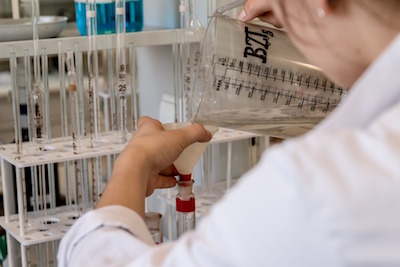
Do you know the differences between and endothermic and exothermic processes? Can you balance a redox reaction? The AP ® Chemistry exam tests topics and skills discussed in your Advanced Placement Chemistry course. If you score high enough, your AP Chemistry score could earn you college credit!
Check out our AP Chemistry Guide for the essential information you need for the exam:
What’s on the AP Chemistry Exam?
The AP Chemistry exam takes 3 hours and 15 minutes to complete. The exam consists of two sections: a multiple-choice section and free-response section. Starting with the Spring 2023 exam, a scientific or graphing calculator is recommend for both sections of the exam per the AP Exam Calculator Policy .
|
Timing |
Number of Questions |
% of Exam Score |
|
|
Section 1 |
90 minutes |
60 multiple choice questions |
50% |
|
Section 2 |
105 minutes |
3 long-form free-response questions |
50% |
AP Chem Review: Topics
The topics of the AP Chemistry Exam are grouped into nine Units.
- Unit 1: Atomic Structure and Properties. Topics may include: moles and molar mass, mass spectroscopy of elements, elemental composition of pure substances, composition of mixtures, atomic structure and electron configuration, photoelectron spectroscopy, periodic trends, valence electrons and ionic compounds.
- Unit 2: Molecular and Ionic Compound Structure and Properties. Topics may include: types of chemical bonds, intramolecular force and potential energy, structure of ionic solids, structure of metals and alloys, Lewis diagrams, resonance and formal charge, VSEPR and bond hybridization.
- Unit 3: Intermolecular Forces and Properties. Topics may include: intermolecular forces, solids, liquids, and gases, kinetic molecular theory, solutions and mixtures, photoelectric effect.
- Unit 4: Chemical Reactions. Topics may include: introduction for reactions, net ionic equations, representations of reactions, physical and chemical changes, stoichiometry, types of chemical reactions.
- Unit 5: Kinetics. Topics may include: reaction rate, introduction to rate law, elementary reactions, collision model, introduction to reaction mechanisms, multistep reaction energy profile, and catalysis.
- Unit 6: Thermodynamics. Topics may include: endothermic and exothermic processes, heat transfer and thermal equilibrium, heat capacity and calorimetry, energy of phase changes, introduction to enthalpy of reaction, enthalpy of formation, Hess’s law.
- Unit 7: Equilibrium. Topics may include: introduction to equilibrium, calculating the equilibrium constant, calculating equilibrium concentrations, introduction to Le Chatelier’s principle, introduction to solubility equilibria, pH and solubility, free energy of dissolution.
- Unit 8: Acids and Bases. Topics may include: introduction to acids and bases, pH and pOH of strong acids and bases, acid-base reactions and buffers, molecular structure of acids and bases, pH and pK a , properties of buffers.
- Unit 9: Applications of Thermodynamics. Topics may include: introduction to entropy, Gibbs free energy and thermodynamic favorability, thermodynamic and kinetic control free energy and equilibrium, galvanic (voltaic) and electrolyte cells, electrolysis and Faraday’s law.
Check out our AP Chemistry Prep and ASAP Chemistry books for a comprehensive content review
AP Chem Question Types
Multiple-Choice
The AP Chem multiple-choice sections contains discrete questions or question sets, in which students are provided with a stimulus or a set of data and a series of related questions.
Grading: This section is scored by a computer.
Free Response
AP Chemistry free response questions assess your ability to:
- Explain, analyze, and interpret models and representations of chemical properties or phenomena
- Design experiments and procedures to test a prediction or theory
- Represent data and chemical phenomena with graphs and diagrams
- Solve problems using mathematical relationships
- Make or justify a scientific claim and support it with evidence and/or reasoning
Grading: You get most of your points on this section for showing the process that got you to the answer. The graders give partial credit when you show them that you know what you’re doing. The responses are scored by a committee of high school and college teachers and are graded according to a standard set at the beginning of the grading period by the chief faculty consultants.
AP Chem Equation Sheet
Tables containing commonly used equations and constants in chemistry are provided with the AP Chemistry exam and can be used on both the multiple-choice and free-response questions. Test takers are also provided with a periodic table of the elements. Check out The College Board's AP Chem Course and Exam Description for more information.
How to Interpret AP Chemistry Scores
AP scores are reported from 1 to 5. Colleges are generally looking for a 4 or 5 on the AP Chemistry exam, but some may grant credit for a 3. (Check out our overview of how to earn AP credit ). Each test is curved so scores vary from year to year. Here’s how students scored on the AP Chemistry exam in May 2022:|
Score |
Meaning |
Percentage of Test Takers |
|
5 |
Extremely qualified |
12.5% |
|
4 |
Well qualified |
17.0% |
|
3 |
Qualified |
24.5% |
|
2 |
Possibly qualified |
23.6% |
|
1 |
No recommendation |
22.5% |
Source: College Board
How Can I Prepare?
AP classes are great, but for many students they’re not enough! For a thorough review of AP Chemistry content and strategy, pick the AP prep option that works best for your goals and learning style.
Read More
Explore Colleges For You
Connect with our featured colleges to find schools that both match your interests and are looking for students like you.
Get Started on Athletic Scholarships & Recruiting!
Join athletes who were discovered, recruited & often received scholarships after connecting with NCSA's 42,000 strong network of coaches.
Best 391 Colleges
170,000 students rate everything from their professors to their campus social scene.



